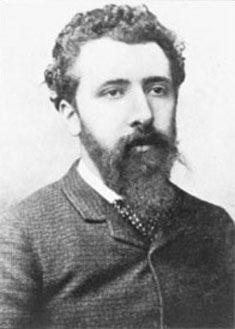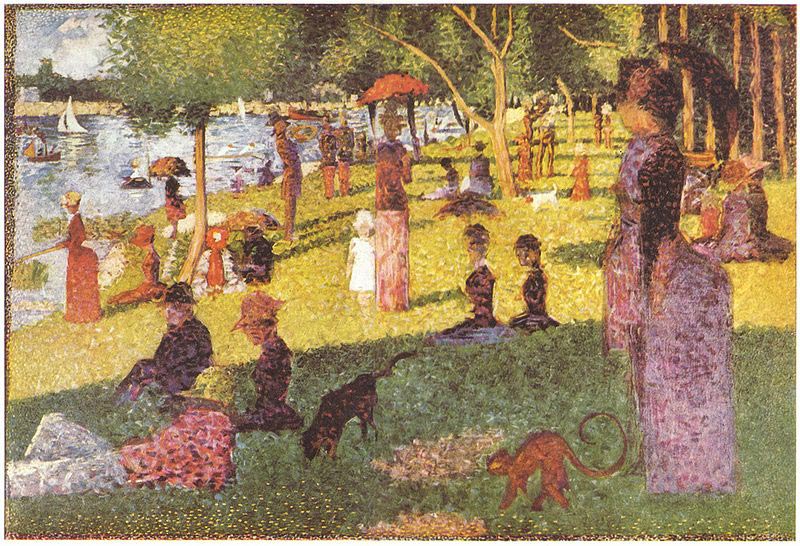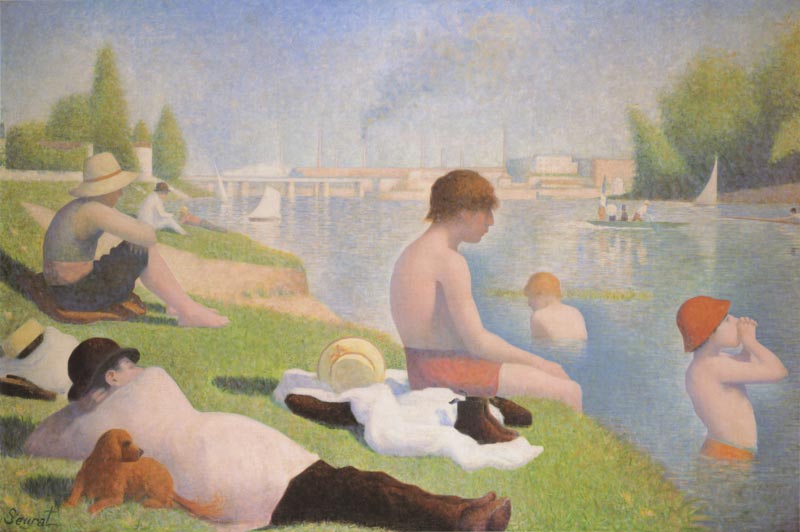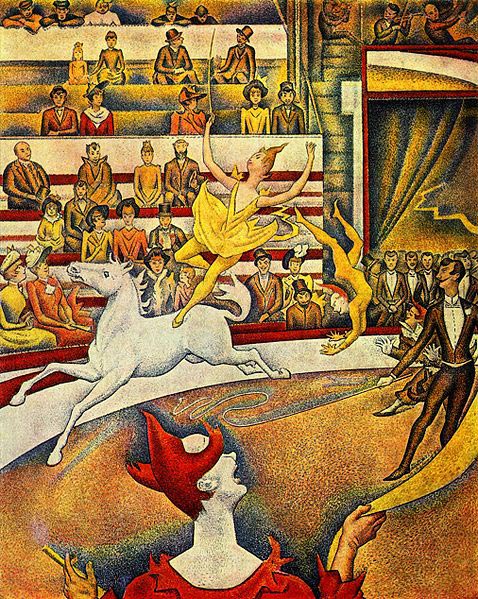| Georges Seurat | |
|---|---|
 |
|
| Born | Dec. 2, 1859 Paris, France |
| Died | Mar. 29, 1891 (at age 31) Paris, France |
| Nationality | French |
| Movement | Post-Impressionism, Neo-impressionism, Pointillism, modern art |
| Field | Painting |
| Works | View Complete Works |
Georges-Pierre Seurat is considered to be the founder of the Neo-Impressionism movement, and is one of the most creative artists of modern art. He was born on December 2, 1859 from a wealthy French family. His father was a legal officer in La Villette, and his mother was a native Parisian from an upper middle class family. He also had two older siblings, a brother named Emile and a sister named Marie-Berthe.
Although Georges had started drawing at a very young age, and relatives from his mother’s side had exposed him to painting, his first formal art training was when he attended drawing classes at a night school under sculptor Justin Lequien in 1875. It was here that he became friends with fellow student, Edmond Aman-Jean. From 1878 to 1879, together with his friend Edmond, Georges went to the Ecole des Beaux-Arts or School of Fine Arts; the same school where almost all of the most famous European artists had undergone training. In his days at the Ecole, Georges’ works were greatly influenced by Rembrandt and de Goya.
It was after this time and before Georges served in the military for one year when he attended the Fourth Impressionist exhibition; an exhibition which featured works from artists like Gauguin, Piette, Monet, and Pissarro. This was the first time Georges had seen paintings that paid no attention to the limits set by rigid academic patterns, and it had opened his eyes into pursuing and developing his own theories. He was particularly devoted to the theory of creating harmony and emotion through the scientific use of optics and complementary colors, having been influenced by the books written by the likes of Michel-Eugène Chevreul and Ogden N. Rood.
 And so it was with this theory, partnered with complex brush strokes, that Georges created his first major artwork, “Bathers at Asnieres”, in 1884 when he was only 24 years old. “Bathers” was a depiction of several figures relaxing and bathing along the Seine during the high summer. In this oil on canvas painting, Georges introduced a technique he used called “balaye” which was a rendering technique making use of crisscrossing brush strokes. He had submitted it for exhibition at the Salon, but was promptly rejected by the jury. This led Georges to form the Societe des Artistes Independants with Odilon Redon, Albert Dubois-Pillet, and Paul Signac during that same year; and so was able to exhibit his work.
And so it was with this theory, partnered with complex brush strokes, that Georges created his first major artwork, “Bathers at Asnieres”, in 1884 when he was only 24 years old. “Bathers” was a depiction of several figures relaxing and bathing along the Seine during the high summer. In this oil on canvas painting, Georges introduced a technique he used called “balaye” which was a rendering technique making use of crisscrossing brush strokes. He had submitted it for exhibition at the Salon, but was promptly rejected by the jury. This led Georges to form the Societe des Artistes Independants with Odilon Redon, Albert Dubois-Pillet, and Paul Signac during that same year; and so was able to exhibit his work.
 Very soon after, Georges started working on his most popular work of art, “Sunday Afternoon on the Island of La Grande Jatte” which was a mural-sized painting approximately 2 x 3 meters. It took him two years to finish (1884-1886), making several trips to the island, and several preliminary drawings and paintings. It was in “Sunday Afternoon” where he introduced his new idea of “chromo-luminarism”, another technique which made use of contrasting dots of colors giving an over-all effect of luminosity and shimmer when viewed from afar. This technique is also variably called today as Pointillism, Neo-Impressionism, or Divisionism. “Sunday Afternoon” was a depiction of figures from different social classes engaged in a variety of park activities, and this painting was exhibited at the Eighth (and last) Impressionist exhibition in 1886. From here on a new art style was invented, and a new art movement was born, drawing national and international attention.
Very soon after, Georges started working on his most popular work of art, “Sunday Afternoon on the Island of La Grande Jatte” which was a mural-sized painting approximately 2 x 3 meters. It took him two years to finish (1884-1886), making several trips to the island, and several preliminary drawings and paintings. It was in “Sunday Afternoon” where he introduced his new idea of “chromo-luminarism”, another technique which made use of contrasting dots of colors giving an over-all effect of luminosity and shimmer when viewed from afar. This technique is also variably called today as Pointillism, Neo-Impressionism, or Divisionism. “Sunday Afternoon” was a depiction of figures from different social classes engaged in a variety of park activities, and this painting was exhibited at the Eighth (and last) Impressionist exhibition in 1886. From here on a new art style was invented, and a new art movement was born, drawing national and international attention.
Georges exhibited “Sunday Afternoon” and other works at the Societe des Artistes Independants also in 1886. By the autumn of that year he began work on “Les Poseuses” which he finished in 1888. “Les Poseuses” depicts three naked female figures in different stages of dressing up after taking a bath. A portion of the painting borrowed some scenes from “Sunday Afternoon”.
In 1887, he began associating with a different group of artists and formed a new group of Neo-Impressionists which included Dubois-Pillet, Pissarro, Charles Angrand, and Maximilien Luce. During this year he re-touched his “Bathers” painting by applying his Pointillism technique. He also briefly served in the military again.
 From 1888 to 1890, Georges created several seascapes while spending his summers in the coast of Normandy. His creations included “Honfleur”, “Port-en-Bessin”, “Le Crotoy”, and “Gravelines”. Sometime in 1889, he traveled to Belgium to exhibit some of his works at the Salon de Vingt (XX). Upon his return, he had met a young but uneducated woman named Madeleine Knobloch. They lived secretly together and on February 16, 1890, their first son, Pierre George was born. It was also in that year that Georges exhibited at the Independants his paintings like “Le Chahut” which were marked with frenzied gesticulations, an effect probably of the works of Jules Cheret which he had collected, and “Young Woman Powdering Herself”, the only known painting which featured Madeleine.
From 1888 to 1890, Georges created several seascapes while spending his summers in the coast of Normandy. His creations included “Honfleur”, “Port-en-Bessin”, “Le Crotoy”, and “Gravelines”. Sometime in 1889, he traveled to Belgium to exhibit some of his works at the Salon de Vingt (XX). Upon his return, he had met a young but uneducated woman named Madeleine Knobloch. They lived secretly together and on February 16, 1890, their first son, Pierre George was born. It was also in that year that Georges exhibited at the Independants his paintings like “Le Chahut” which were marked with frenzied gesticulations, an effect probably of the works of Jules Cheret which he had collected, and “Young Woman Powdering Herself”, the only known painting which featured Madeleine.
In 1891, while Madeleine was again pregnant, and while Georges was working on “The Circus”, he fell ill and died a few days later on March 29. He left his last work unfinished. He was only 31 years old.
Today, “Bathers at Asnieres” can be seen at the National Gallery in London, “Summer Afternoon” is a permanent collection at the Art Institute of Chicago, and “Young Woman” is at the Courtauld Institute of Art in London.